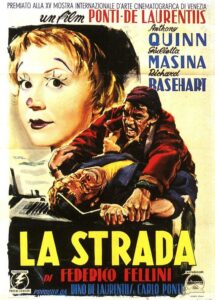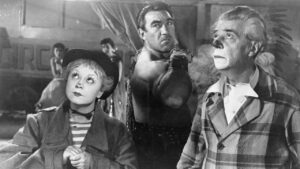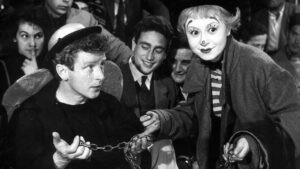“La Strada” – the Purifying Power of Love [analysis]

Title: “La Strada”
Release date: 1954
Director: Federico Fellini
Cast: Antohny Quinn, Giulietta Masina, Richard Basehart
“La Strada” is one of the most important movies of Federico Fellini and at the same time an interpretation of the guiding idea of the Italian director’s work. The story of the impulsive circus strongman Zampano and his shy sidekick provokes the question whether love is really capable of transforming even the most hardened heart. Fellini seems to answer it positively, while at the same time showing that even behind the simplest mental structure can hide a rich inner life.
“La Strada” – Zampano and Gelsomina
“La Strada” is a movie that in a sense grows out of the biography of Fellini, who claimed that as a teenager he ran away from home and got involved with a traveling acting troupe. Although this was probably a myth, his love of the circus grew out of the director’s legend and was reflected in his oeuvre, for similar motifs appear in almost all of the famous director’s films. In “La Strada” we follow the story of a circus performer named Zampano, who one day in a seaside town buys her mentally retarded daughter Gelsomina from an elderly woman. The girl becomes his helper at work, soon learning to play the trumpet and performing funny numbers with Zampano. Unfortunately, the donkey has a very impulsive nature, bullying Gelsomina and sexually abusing her. In the end, the girl decides to run away from the cruel man, but after talking to the circus lineman the Fool, she comes to the conclusion that Zampano has no one in the world but her and she should take care of him.
One day the man, who has long been in conflict with the Fool (Richard Basehart), goes on a rampage and kills him. The shocked Gelsomina then begins to get sick and loses touch with reality. Zampano then leaves her in some desolate place. Years later, when he ends up in the same village with a traveling show, he learns that the girl has died. In the evening on the seashore, Zampano bursts into what is probably the first bitter cry of his life.

“La Strada” – a parabolic picture of the world
“La Strada” is a film that can be read in a parabolic key, that is, it can be treated as a kind of parable operating with allegories and symbols. The reality depicted here is universal in nature, it is reduced to the realities of circus life, which makes the world function as a great theater. In turn, the characters appearing on its stage are not only concrete figures, but also embody certain ideas and values. Therefore, Gelsomina can be seen as an allegory of boundless love, Zampano as the embodiment of human transgressions, and the Fool as a perverse fantasy.
Cinematography and music play a very important role in building this parabolic layer of the film. The monochromatic landscape, almost devoid of the charm of Italian corners, gives the impression of being austere and repulsive. This is a world that rarely hosts beauty and happiness, only occasionally illuminated by Gelsomina’s cheerful smile. Nino Rota’s music brilliantly highlights the emotional details of the story depicted. In turn, the most moving is the part performed by the main character on the trumpet. It is this nostalgic melody that reminds Zampano of Gelsomina and her pure love.
“La Strada” in its parabolic dimension, however, would have been unsuccessful if it were not for the superb acting of the actors playing the main roles. Anthony Quinn and Giulietta Masina (privately Federico Fellini’s wife) created unremarkable and, above all, extremely believable creations of simple people with enormous emotional potential. Masina’s Gelsomina is, as it were, a character from a different, supernatural order – through her naiveté and failure to adapt to the cruel rules of the world, she brightly highlights its corruption.

“La Strada” – a Franciscan story of redemption
Gelsomina from “La Strada” can also be seen as a messianic heroine, whose undeserved suffering and death lead to the redemption of Zampano’s guilt. Such a view of this character harmonizes with numerous Christian tropes, especially the reference to Franciscan philosophy. These can be seen in the poverty of the heroine, as well as the role attributed to nature in shaping Gelsomina’s attitude. Told by the Fool and at the same time Franciscan in spirit, the story about a small pebble that plays an important role in the order of the world gives meaning to the girl’s actions.
It is nature that has a purifying power in it. It is no coincidence that in the last scene Zampano bursts out crying on the seashore. In Fellini’s oeuvre, the sea element almost always brings solace and an existential washing of guilt. In a similar form – also in the finale – this setting appears, for example, in “Dolce vita” “La Strada” is therefore, above all, a story about love that saves and cleanses even the most hardened hearts.
Literature:
“Kino klasyczne”, pod red. T. Lubelskiego, I. Sowińskiej i R. Syski, Kraków 2012.
A. Garbicz, J. Klinowski, „Kino, wehikuł magiczny. Przewodnik osiągnięć filmu fabularnego. Podróż druga 1950 – 1959”, Kraków 1987.
J. Guze, „Wśród bohaterów kina”, Warszawa 1983.
